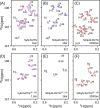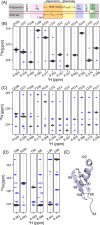Experimental NOE, Chemical Shift, and Proline Isomerization Data Provide Detailed Insights into Amelotin Oligomerization
- PMID: 37548612
- PMCID: PMC10436275
- DOI: 10.1021/jacs.3c05710
Experimental NOE, Chemical Shift, and Proline Isomerization Data Provide Detailed Insights into Amelotin Oligomerization
Abstract
Amelotin is an intrinsically disordered protein (IDP) rich in Pro residues and is involved in hydroxyapatite mineralization. It rapidly oligomerizes under physiological conditions of pH and pressure but reverts to its monomeric IDP state at elevated pressure. We identified a 105-residue segment of the protein that becomes ordered upon oligomerization, and we used pressure-jump NMR spectroscopy to measure long-range NOE contacts that exist exclusively in the oligomeric NMR-invisible state. The kinetics of oligomerization and dissociation were probed at the residue-specific level, revealing that the oligomerization process is initiated in the C-terminal half of the segment. Using pressure-jump NMR, the degree of order in the oligomer at the sites of Pro residues was probed by monitoring changes in cis/trans equilibria relative to the IDP state after long-term equilibration under oligomerizing conditions. Whereas most Pro residues revert to trans in the oligomeric state, Pro-49 favors a cis configuration and three Pro residues retain an unchanged cis fraction, pointing to their local lack of order in the oligomeric state. NOE contacts and secondary 13C chemical shifts in the oligomeric state indicate the presence of an 11-residue α-helix, preceded by a small intramolecular antiparallel β-sheet, with slower formation of long-range intermolecular interactions to N-terminal residues. Although none of the models generated by AlphaFold2 for the amelotin monomer was consistent with experimental data, subunits of a hexamer generated by AlphaFold-Multimer satisfied intramolecular NOE and chemical shift data and may provide a starting point for developing atomic models for the oligomeric state.
Conflict of interest statement
The authors declare no competing financial interest.
Figures







Similar articles
-
Proline Peptide Bond Isomerization in Ubiquitin Under Folding and Denaturing Conditions by Pressure-Jump NMR.J Mol Biol. 2024 Jun 1;436(11):168587. doi: 10.1016/j.jmb.2024.168587. Epub 2024 Apr 23. J Mol Biol. 2024. PMID: 38663546 Free PMC article.
-
1H- and 13C-NMR investigations on cis-trans isomerization of proline peptide bonds and conformation of aromatic side chains in H-Trp-(Pro)n-Tyr-OH peptides.Biopolymers. 1993 May;33(5):781-95. doi: 10.1002/bip.360330507. Biopolymers. 1993. PMID: 8393714
-
Site-specific NMR monitoring of cis-trans isomerization in the folding of the proline-rich collagen triple helix.Biochemistry. 2000 Apr 18;39(15):4299-308. doi: 10.1021/bi992584r. Biochemistry. 2000. PMID: 10757978
-
Thermodynamic origin of cis/trans isomers of a proline-containing beta-turn model dipeptide in aqueous solution: a combined variable temperature 1H-NMR, two-dimensional 1H,1H gradient enhanced nuclear Overhauser effect spectroscopy (NOESY), one-dimensional steady-state intermolecular 13C,1H NOE, and molecular dynamics study.Biopolymers. 2000 Jan;53(1):72-83. doi: 10.1002/(SICI)1097-0282(200001)53:1<72::AID-BIP7>3.0.CO;2-5. Biopolymers. 2000. PMID: 10644952
-
Proline isomerization in the C-terminal region of HSP27.Cell Stress Chaperones. 2017 Jul;22(4):639-651. doi: 10.1007/s12192-017-0791-z. Epub 2017 May 25. Cell Stress Chaperones. 2017. PMID: 28547731 Free PMC article.
Cited by
-
From Milliseconds to Minutes: Melittin Self-Assembly from Concerted Non-Equilibrium Pressure-Jump and Equilibrium Relaxation Nuclear Magnetic Resonance.J Phys Chem Lett. 2024 Feb 22;15(7):1930-1935. doi: 10.1021/acs.jpclett.3c03563. Epub 2024 Feb 12. J Phys Chem Lett. 2024. PMID: 38346015 Free PMC article.
-
The power and pitfalls of AlphaFold2 for structure prediction beyond rigid globular proteins.Nat Chem Biol. 2024 Aug;20(8):950-959. doi: 10.1038/s41589-024-01638-w. Epub 2024 Jun 21. Nat Chem Biol. 2024. PMID: 38907110 Free PMC article. Review.
-
Proline Peptide Bond Isomerization in Ubiquitin Under Folding and Denaturing Conditions by Pressure-Jump NMR.J Mol Biol. 2024 Jun 1;436(11):168587. doi: 10.1016/j.jmb.2024.168587. Epub 2024 Apr 23. J Mol Biol. 2024. PMID: 38663546 Free PMC article.
References
-
- Foguel D.; Suarez M. C.; Ferrao-Gonzales A. D.; Porto T. C. R.; Palmieri L.; Einsiedler C. M.; Andrade L. R.; Lashuel H. A.; Lansbury P. T.; Kelly J. W.; Silva J. L. Dissociation of amyloid fibrils of alpha-synuclein and transthyretin by pressure reveals their reversible nature and the formation of water-excluded cavities. Proc. Natl. Acad. Sci. U. S. A. 2003, 100 (17), 9831–9836. 10.1073/pnas.1734009100. - DOI - PMC - PubMed
Publication types
MeSH terms
Substances
Grants and funding
LinkOut - more resources
Full Text Sources

